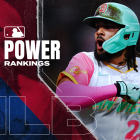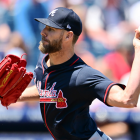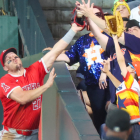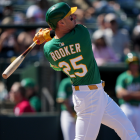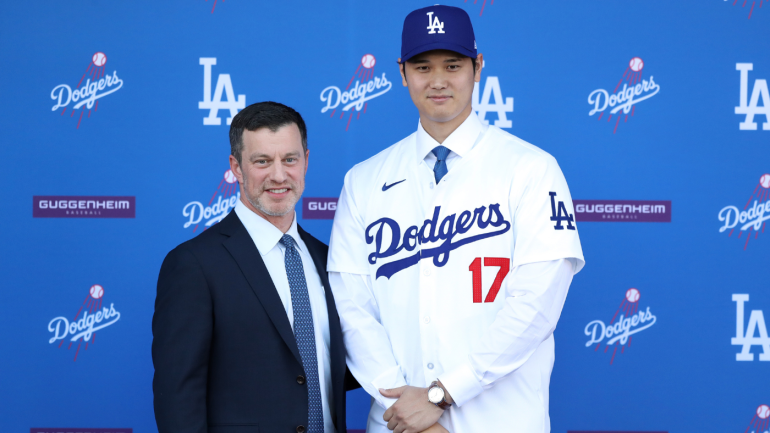
When it comes to Shohei Ohtani's free agent contract with the Los Angeles Dodgers, the only thing more shocking than the $700 million payout is how all those dollars are, you know, paid out.
Ohtani's pact, which ostensibly runs 10 years, includes not only unprecedented but also, frankly, unimagined deferrals. Specifically, during those 10 years, he'll receive just $2 million of his $70 million owed per season in the standard manner. That vast remainder of $68 million will be out at much later dates. If you'd like to think of it in big-picture terms, $680 million of that $700 million won't be paid on time by mutual agreement.
Because of the breadth and sprawl of Ohtani's contract, there's some percolating concern about what it means for baseball. Since it involves one of the wealthiest franchises in MLB, many of those concerns center on competitive balance and whether the Ohtani Model is now something other big spenders will try to ape it with other big stars. As is the case when anything like this happens, it's not hard to find calls for a salary cap.
Given such chatter, it's time to lay out why the Ohtani contract with L.A. isn't anything to worry about and certainly isn't cause to implement any kind of rigid salary structure in MLB. Let's look at five reasons.
1. Ohtani is a unique case
It's often hard to determine whether something new is the start of a trend or an outlier. In this instance, though, all signs point determinedly toward "outlier." When talking about a player who is among the best pure hitters in all of baseball and also pitches like a Cy Young candidate – all at the same time, health permitting – we're dealing with a sample size of one. Making Ohtani even more indisputably unique is that he's an international super(duper)star with unmatched prowess among baseball players when it comes to driving ticket sales, pumping up broadcast ratings, and fetching sponsorship and advertising opportunities for his club. In these ways, Ohtani is as rare off the field as he is on it.
Speaking of all of this, something else that sets Ohtani apart from, well, everyone else is his non-salary earning power. It's estimted he makes up to $50 million each year in endorsements, and that figure will surely rise now that he's linked to the flagship Dodger brand. It's that lofty earning potential that in large measure makes him willing to make these hefty deferrals. There's been some worrying that Ohtani's deferrals, which as you've surmised may be described as "hugely huge," might set a bad precedent for future free-agent superstars like Juan Soto. Superstar free agents, however, don't have to agree to such things, and they have the power and leverage not to. Soto's camp could simply say, yes, we're open to deferring 97% of annual salary provided you pay us $700 million and guarantee us $50 million or so in annual endorsement earnings. You get the idea.
The preceding has been about how unique Ohtani's case is. What isn't unique is the general notion of heavy deferrals. They've been around for decades in MLB, going back further than notable cases like Bobby Bonilla and Ken Griffey Jr. Max Scherzer when he inked with the Nationals prior to the 2015 deferred half of his $210 million contract. Nolan Arenado's contract with the Cardinals runs through 2027, but they'll be paying him through 2041. Those are just a few of many, many examples. The scale of Ohtani's deferrals is unexampled, but the notion of high-dollar, interest-free deferrals is very much not.
2. The deferrals make the $700 million price tag misleading
If you've been following any of the Ohtani contract coverage, then you've surely been assaulted by life-diminishing financial terms like "future value of money" and "net present value" and so forth. They're all premised on the (entirely) true notion that a dollar today is worth more than a dollar tomorrow. That's because the steady march of inflation means a dollar today has more purchasing power than a dollar in the future. There's also the opportunity to make interest on a dollar earned today, whereas a dollar you get at some future date provides no such opportunities until you get that dollar. In the case of a player deferring money like Ohtani has, it's better phrased as, "a dollar tomorrow is worth less than a dollar today."
Ohtani isn't receiving that $700 million in the standard manner, and he won't get the vast majority of that money until many years into the future. By applying a discount rate, we can put a present dollar figure on long-term contracts and see how much they're truly worth.
Jon Becker did the heavy lifting using the discount rate used by MLB and MLBPA in their relevant calculations (more on those in a moment):
FINAL, COMPLETELY CORRECT MATH:
— Jon Becker (@jonbecker_) December 11, 2023
•The discount rate is 4.43%
•The present value of the $68M is $44,081,476.50
•This makes the AAV of each year $46,081,476.50 (the above + $2M, which isn't discounted)
•The present value of the contract in total is $460,814,764.97
Had Ohtani signed, say, a 10-year, $550 million deal paid out in equal installments over those 10 years would we be worrying like this and calling for salary caps or bans on deferred salaries? Very likely not. So if it helps, think of what Ohtani's contract is truly worth, which is less than $500 million.
Another way to think of it is the fact that even a player as great as Ohtani never would've sniffed $700 million paid out over 10 years. Instead – and as Ben Lindbergh capably pointed out – he gets a present value figure that's in line with general industry expectations. Ohtani and his agent Nez Balelo get to lay claim to the largest player contract in sports history, and the Dodgers get, in essence, a free loan from Ohtani and flexibility to do even more to an already powerhouse roster. That brings us to the next point.
3. Baseball already has a de-facto 'soft' cap
MLB restricts top-end team payrolls with something euphemistically called the Competitive Balance Tax (CBT or, more commonly, the luxury tax). Teams that exceed the CBT threshold for a given year (it's $237 million for the upcoming season) pay overage penalties based on how much they exceed the threshold and whether they've been in "penalty territory" for consecutive years. It works like this:
- First year: 20% tax on payroll above CBT threshold
- Second consecutive year: 30% tax
- Third consecutive year or more: 50% tax
As well, teams are penalized for the extent to which they exceed the threshold figure in a given year:
- $20 million to $40 million: 12% surcharge
- $40 million to $60 million: 42.5% surcharge for first year; 45% for each consecutive year after that
- $60 million or more: 60% surcharge
Each year, at most a handful of clubs are above the CBT line, and even those that do venture into such forbidden territory partake in the occasional reset year to get out from under those consecutive-years multipliers. So, yes, the CBT does indeed function as a soft salary cap.
As for calculating each team's payroll for CBT purposes, the average annual value (AAV) for multi-year contracts is used. For instance, a hypothetical player on a two-year, $20 million contract who's paid $5 million in year one and $15 million in year two is nevertheless a $10 million CBT hit in both years because that's the average annual value of his contract. In Ohtani's case, his AAV is not $70 million – $700 million over the stated 10 years of the contract – but something around $46 million because of those massive deferrals spread across many years. You'll recognize that $46 million figure as reflective of the present-day value of Ohtani's Dodgers contract noted above spread across the 10 years of that contract.
That the Dodgers and Ohtani achieved such a low AAV for a $700 million commitment speaks to the fact that even a team like the Dodgers with vast coffers operates with one eye on the CBT. Call that manipulation if you like, but also note that even supposedly "hard" capped leagues in other sports permit similar machinations.
4. The real problem is at the other end of the spending continuum
The pairing of perhaps the top free agent ever and the big-spending Dodgers naturally put the focus on the top end of payrolls. MLB's bigger problem, though, is at the other end – the teams who won't spend despite being highly profitable and raking in lots of shared revenues based on nothing more than their mere existence.
To repeat what you surely already know, MLB teams aren't obligated to disclose their financials, and when they do voluntarily hint at them they do so for specific purposes – to get fans off their backs or to position themselves for corporate-welfare handouts, for instance. Also, on those rare occasions that team financials have seen the light of day, even the putative underclass of MLB has been revealed to be highly profitable. The forensic-accounting efforts like those that Forbes undertakes each year also shows that almost all MLB clubs are quite healthy in terms of finances.
A's saboteur John Fisher is the worst current embodiment of all the negative traits of ownership. However, it's the Orioles and John Angelos who are the current main offenders among teams that are actually good. The Orioles won 101 games last season and prevailed in the brutal American League East thanks to a deeply impressive young core that was assembled largely through tanking. This is the time to lean into that core with star additions via free agency or via taking on salary in trades, but Angelos has shown almost no willingness to do that. The O's last season ranked 29th in Opening Day 26-man payroll, which amounts to a gross dereliction of duty on the part of ownership. While Baltimore payroll is tracking modestly upward for 2024, it's still nothing close to what the payroll should be for a World Series contender. The Orioles are of course just a recent example, as this disinvestment on the part of middle-market contenders is a long-standing trend. Owners who would rather pocket their take of shared revenues instead of putting it toward the on-field product are the biggest problem with MLB right now.
A common accompaniment to any call for a salary cap in baseball is to yoke it to a salary floor. The most fundamental problem is that the Players Association, the strongest union in sports, is never going to agree to a hard cap on principled grounds. Likewise, they've time and again batted down talk of a salary floor based on those same principles. What MLB should do is put some teeth into the (presently inadequate) requirements that revenue-sharing recipients put those monies back into the club. This is something that players support, as well as the large-market teams that send out all that money. That step would do more for parity, which let it be said baseball is absolutely not lacking, than any kind of hard cap would.
5. Baseball already has a great deal of parity
The ostensible point of a salary cap (the actual point is to lower labor costs for owners) is to promote competitive balance. Baseball, though, has a great deal of inherent structural parity because of the nature of the sport. The simple reality – and one that becomes even more predominant as the league continues to add layers to the postseason – is that the best teams don't win the World Series all that often. In contrast, some of the weakest teams in the playoffs run the gauntlet almost as often as thus juggernauts do. That's baseball, which is prone to wild levels of randomness across the small sample size that is the postseason.
Speaking of which, MLB has and has for a long time superior competitive balance compared to capped leagues. My CBS Sports colleague Matt Snyder did a great job of making that case, thoroughly backed by data, in early 2022. His points still hold, of course. A hard cap in baseball remains an impossibility because of the realities of the labor situation, but the adoption of it would also be wholly unnecessary.
As jarring and unparalleled as the Ohtani contract is in terms of value and structure, it doesn't really change anything. When it comes to baseball's thoroughly nonexistent need for a salary cap, it changes absolutely nothing.
![[object Object] Logo](https://sportshub.cbsistatic.com/i/2020/04/22/e9ceb731-8b3f-4c60-98fe-090ab66a2997/screen-shot-2020-04-22-at-11-04-56-am.png)









